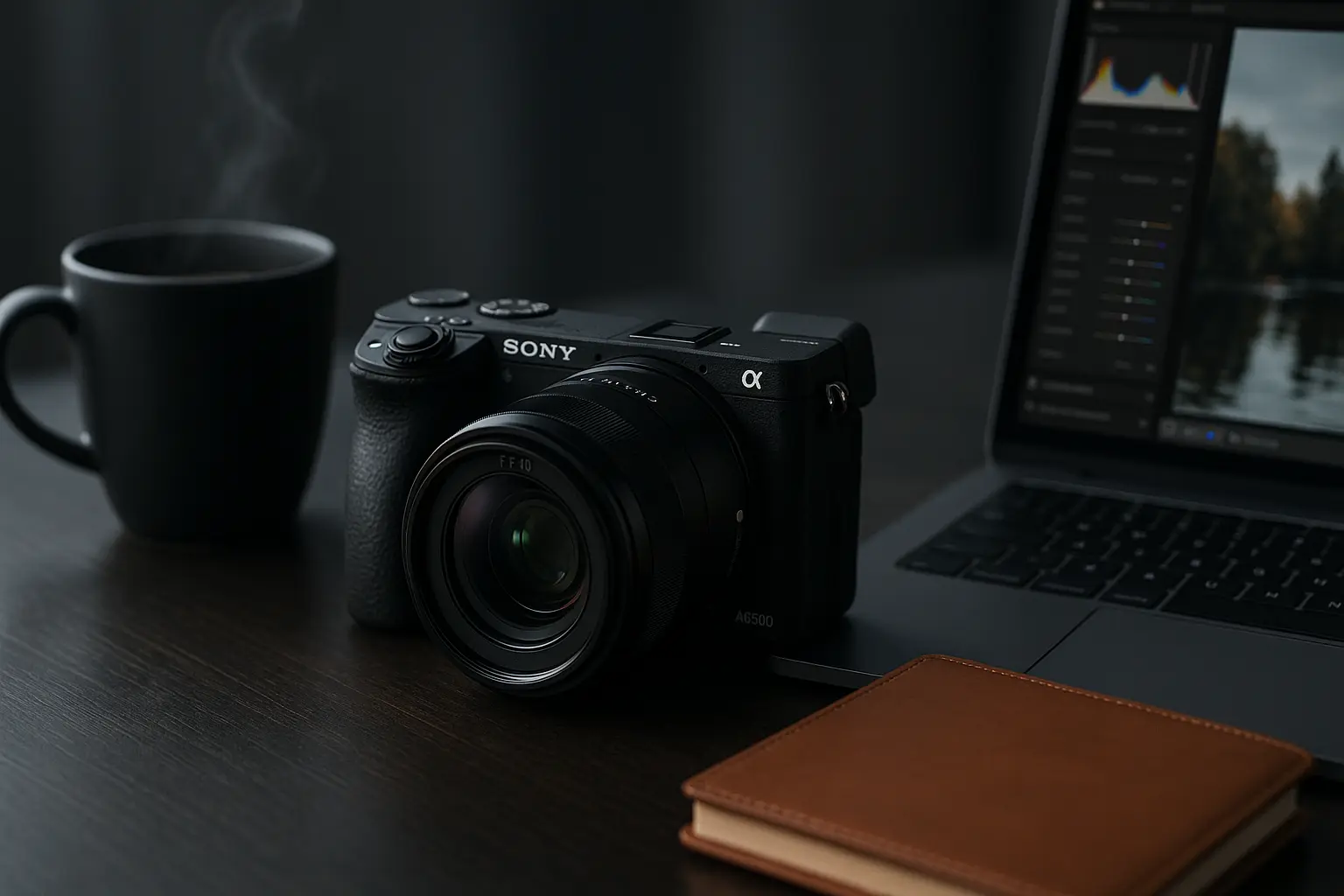Let’s get one thing straight from the very start: it’s 2025, and talk about a camera from end 2016 can be like referencing a fossil. In the whirlwind world of digital cameras, nine years is nothing short of an eternity. Still, the Sony A6500 mirrorless camera surfaces on forums, on used market websites, and on the backpacks of discerning creators. But why? That’s the behemoth question to which we’re about to give answers.
As we noted in our 2024 roundup of top photography cameras, mirrorless models owe their dominance to features like fast autofocus and burst speed exact strengths that keep the A6500 in the conversation.
I spent some significant time with Sony’s Alpha line, from early NEX days through to modern full-frame titans. At its A6500 release, it was revolutionizing for the APS-C series. It followed on from its predecessor, Sony’s A6300, inheriting its spectacular autofocus and image quality and adding the final piece anyone was asking for: 5-axis in-body image stabilization (IBIS). That one feature cemented its role as both photography and video hybrid powerhouse.
But now, with newer, higher-end models like the A6400 and A6600 available, is this aging workhorse still worth its keep? Is it an underappreciated gem on used equipment listings or outdated gear? This comprehensive 2025 Sony A6500 review will pick its performance apart, its weaknesses, and lastly, whether it’s still a wise purchase for you today.
2. Quick Specs Overview
Before we dive deep into how this camera feels and performs, let’s get the technical stuff out of the way. Specs can be boring, but they tell a big part of the story. I’ve broken down the key features of the Sony A6500 and translated them into what they actually mean for you when you’re out shooting.
| Feature | Specification | What This Means in Simple Terms |
|---|---|---|
| Sensor | 24.2MP APS-C CMOS Sensor | You get sharp, detailed photos with plenty of room to crop. It’s great in low light and gives you that lovely blurred background (bokeh). |
| Image Stabilization | 5-Axis In-Body (IBIS) | This is the A6500’s secret weapon. It physically moves the sensor to counteract your shaky hands, giving you sharper photos and smoother handheld video, even with lenses that don’t have stabilization. |
| Autofocus System | 425 Phase-Detection Points | The camera can find and lock onto your subject incredibly fast, almost anywhere on the screen. It’s fantastic for tracking moving subjects. |
| Continuous Shooting | Up to 11 fps (frames per second) | Perfect for action. You can hold down the shutter and capture a rapid burst of photos to make sure you don’t miss the perfect moment. |
| Video Resolution | 4K at 24/30p & 1080p up to 120p | You can shoot professional-looking 4K video and create amazing slow-motion footage in Full HD. |
| ISO Range | 100 – 25600 (exp. to 51200) | A measure of light sensitivity. It performs well in dim situations like indoor events or evening cityscapes, though it gets a bit noisy at the highest settings. |
| Viewfinder (EVF) | 2.36m-Dot OLED | A crisp and bright electronic viewfinder that shows you a live preview of your exposure and settings. What you see is what you get. |
| LCD Screen | 3.0″ Tilting Touchscreen | The screen tilts up and down for shooting at creative angles. The touch capability is mainly for picking your focus point, not for navigating menus. |
| Ports | Micro-HDMI, Micro-USB, 3.5mm Mic Jack | You can connect it to a TV or monitor, charge it via USB, and most importantly, attach an external microphone for way better audio quality in your videos. |
| Build | Magnesium Alloy Body | It feels solid and durable in your hands, much more premium than plastic-bodied cameras. It also has some weather sealing against dust and moisture. |
As you can see, even by 2025 standards, that’s a powerful list. The combination of IBIS, 4K video, and a killer autofocus system is what keeps the Sony A6500 in the conversation.
For detailed specs from Sony:
3. Design and Build Quality
The moment you pick up the Sony A6500, you feel it. It’s got this solid, dense vibe without being heavy perfect for tossing in your bag for a trip. The magnesium alloy body gives it that premium, “this thing can take a beating” kind of confidence. It’s not some flimsy plastic toy; it feels like a legit piece of gear you can trust on your adventures.
The grip is a total game-changer compared to older models like the A6000. It’s deeper, comfier, and just molds to your hand. I’ve wandered around for hours with this camera and a mid-sized zoom lens, and it never felt clunky or like it was gonna slip out of my hand. It just works.
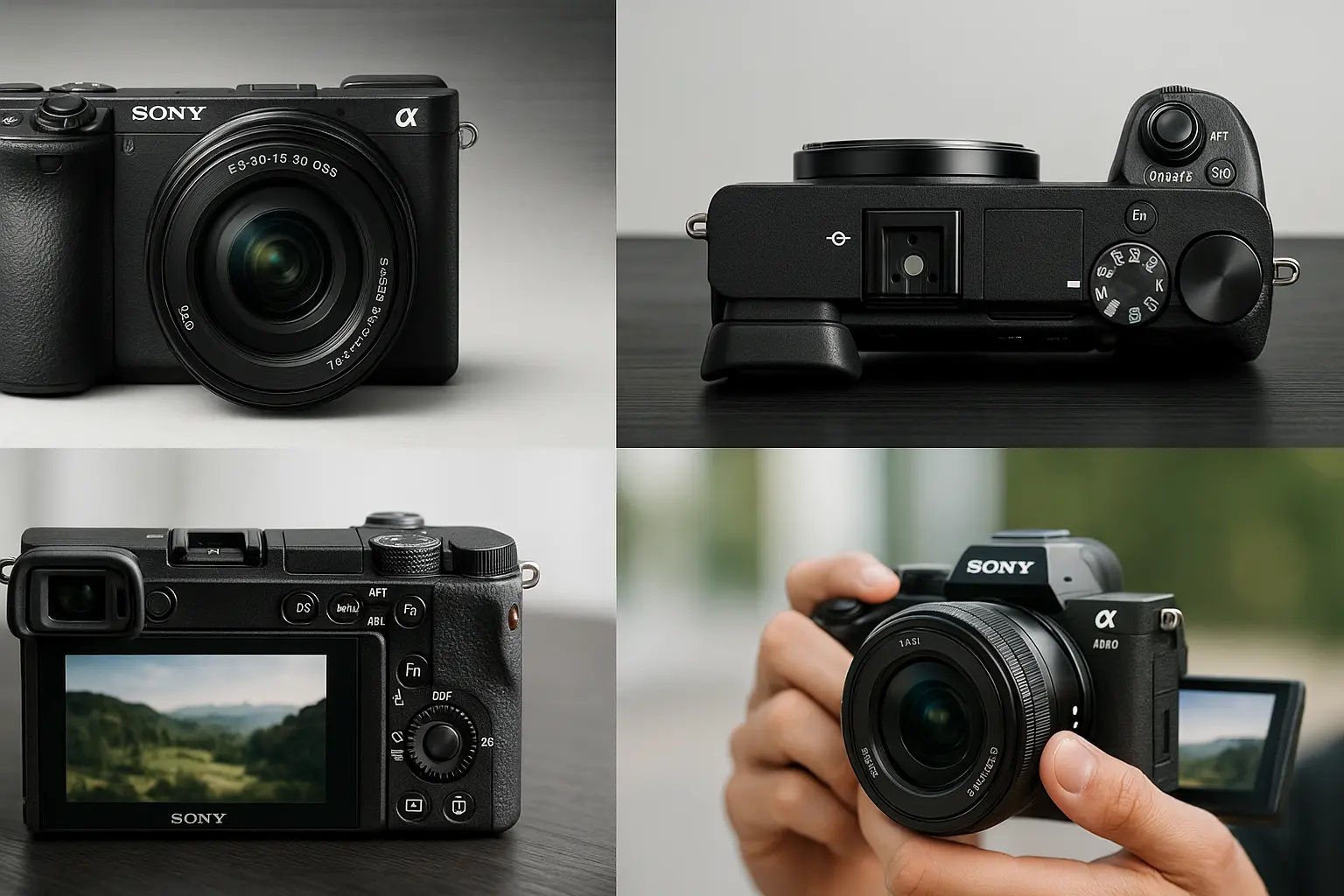
The buttons and dials? Pretty standard Sony stuff for the time. You get a couple of customizable buttons (C1 and C2), which are a lifesaver once you tweak them to do what you want I’ve got one set to Eye AF for quick access. It makes switching settings on the fly super easy without menu-diving. Speaking of menus, yeah, Sony’s old menu system is a bit of a puzzle at first. It takes some patience to set it up just right, but once you do, you’re golden and barely need to mess with it.
Now, the screen. It’s a 3-inch tilting display, which is awesome for shooting low angles or over crowds. But, vloggers, listen up: it doesn’t flip forward 180 degrees. If you need to see yourself while filming, this isn’t your camera. Also, the touchscreen is pretty basic you can tap to set focus, but don’t expect to swipe through menus like on your phone.
The electronic viewfinder (EVF), though? Total win. It’s crisp, bright, and a lifesaver when you’re shooting in blazing sunlight and the back screen’s just a glare-y mess.
All in all, the A6500’s design nails it. It’s compact and light enough to never feel like a burden, but sturdy and comfy enough to feel like a pro tool you can rely on.
4. Photo and Autofocus Performance
Man, this is where the Sony A6500 really shines, even in 2025. That 24.2-megapixel APS-C sensor? It might not be the newest kid on the block, but it’s still a total champ. The photos come out crazy sharp, super clean, and packed with detail. The colors are classic Sony bright, punchy, and just look good straight out of the camera. Plus, the RAW files give you so much room to play with in editing, letting you pull back details from shadows or highlights like it’s no big deal.
But the real star of the show is the autofocus.
I took this camera out for an afternoon of street photography and then to a park try and get some shots of my friend’s chaotic but lovable golden retriever. In both situations, the AF was just fantastic. The 425 phase-detection points are spread so wide across the frame that you can place your subject almost anywhere and the camera just snaps into focus instantly. There’s very little “focus and recompose” needed.
The Eye AF is a genuine game-changer, especially for portraits. On the A6500, you typically assign it to a custom button. When you hold it down, a little green box appears and locks onto your subject’s eye with creepy precision. It stays glued on even if they turn their head slightly. It makes getting perfectly sharp portraits almost effortless. Is it as advanced as the Real-time Eye AF on newer models that finds the eye automatically? No. But it’s still incredibly effective and reliable.
Subject tracking is also shockingly good. Trying to photograph that dog, I put the camera in tracking mode, locked onto him, and the focus points swarmed over him as he darted around the park. While it occasionally lost him against a busy background, it successfully tracked him about 80-90% of the time, giving me a ton of sharp keepers. For its time, and even now in 2025, the Sony A6500 camera autofocus system is a powerhouse.
I did most of my testing with two classic lenses: the ultra-sharp Sigma 30mm f/1.4 DC DN for low-light and portraits, and the versatile Sony E 18-105mm f/4 G OSS for general walkaround use. The camera had no problem driving either lens quickly and accurately. In low light, the AF does slow down a touch and you might see it hunt for a moment in a dimly lit room, but it almost always finds its mark. For a camera of this age, its performance is nothing short of impressive.
5. Video Quality and Image Stabilization
Dude, the Sony A6500 is an absolute legend when it comes to video. Even in 2025, this thing is killing it for way less money than you’d expect. Back in its prime, every indie filmmaker, YouTuber, and scrappy creator was obsessed with it because it gave you pro-level video without needing to sell your car. And guess what? It’s still got it.
The 4K footage? Oh man, it’s stunning. It grabs a massive 6K image from the sensor and squashes it down to 4K, which makes everything crazy sharp and bursting with detail. If you want to edit a 4K video then you must have a powerful desktop CPU or a Laptop. It legit holds its own against fancy new cameras that cost a fortune. Want that smooth, cinematic vibe? Shoot at 24fps. Need something more standard? Go for 30fps. And if you’re into slow-mo, you can crank out 1080p at 120fps for that buttery, dreamy effect.
But the real magic? That 5-axis in-body image stabilization (IBIS). It’s what makes this camera a cut above its cousin, the A6400.
IBIS is like having a superpower for handheld shooting. Seriously, it’s a total game-changer. The sensor actually moves to cancel out all those little shakes from your hands. You can shoot smooth, pro-looking footage without dragging a gimbal everywhere. Slow pans or still shots? They’re rock-steady. Walking around? It’s not quite gimbal-smooth, but those annoying jitters are gone, and the motion feels natural and watchable. Best part? It works with any lens your cheap prime, that quirky vintage glass, you name it.
If you’re a video nerd like me, you’ll love that the A6500 has Picture Profiles like S-Log2 and S-Log3. These give you this flat, kinda dull-looking footage on purpose. Sounds weird, right? But it’s loaded with so much data in the highlights and shadows that you can tweak it in editing to get that slick, Hollywood-style look.
Offers an Intel-based alternative for editors who prefer Quick Sync for H.264 footage from the A6500.
So, where does this camera fit in 2025? It’s still a total steal for filmmaking, a trusty B-camera, or anyone shooting travel vlogs or documentaries on a budget. But vlogging? Okay, here’s the deal: the IBIS and mic input are awesome, but there’s no flip-out screen to see yourself. You’re basically guessing your framing, which is a bummer for most vloggers.
6. Overheating and Battery Life
Alright, let’s get real about the two big gripes people have with the Sony A6500: overheating and battery life. If you’ve poked around online, you’ve probably seen folks complaining about these. So, let’s dive in and break it down, no sugarcoating.
The Overheating Situation
Yeah, the A6500 can get toasty. Packing a beefy sensor and processor that can shoot 4K into a tiny metal body? That’s like cramming a sports car engine into a go-kart it’s gonna heat up. For photos, it’s no big deal at all. But if you’re filming long videos, you’ll hit that overheating wall.
Here’s the deal from my own testing:
- Indoors at normal room temp (like 70°F / 21°C), you’ll probably get an overheating warning after about 20-25 minutes of nonstop 4K recording.
- Outside on a hot, sunny day? That could drop to 15 minutes or less.
But here’s the thing: most people aren’t shooting 25-minute takes. If you’re doing short clips (like 1-3 minutes for vlogs or projects), you might never even notice the heat. Got a long interview, wedding ceremony, or soccer game to film? You’ll need some tricks up your sleeve.
When you mention using better hardware for processing 4K video, this next-gen GPUs article adds value.
Here’s how to keep the A6500 cool:
- Flip out the screen: Just pull the LCD away from the camera body. It lets heat escape instead of getting trapped.
- Use a dummy battery: The battery itself gets hot. Swap it for a dummy battery hooked to a USB power bank or wall outlet it keeps things cooler and gives you unlimited juice.
- Avoid direct sun: That black camera body sucks up sunlight like nobody’s business. Keep it shaded when you can.
- Tweak the temp setting: Dig into the menu for “Auto Pwr OFF Temp” and set it to “High.” It won’t fix everything, but it lets the camera handle more heat before shutting down.
The Battery Life Struggle
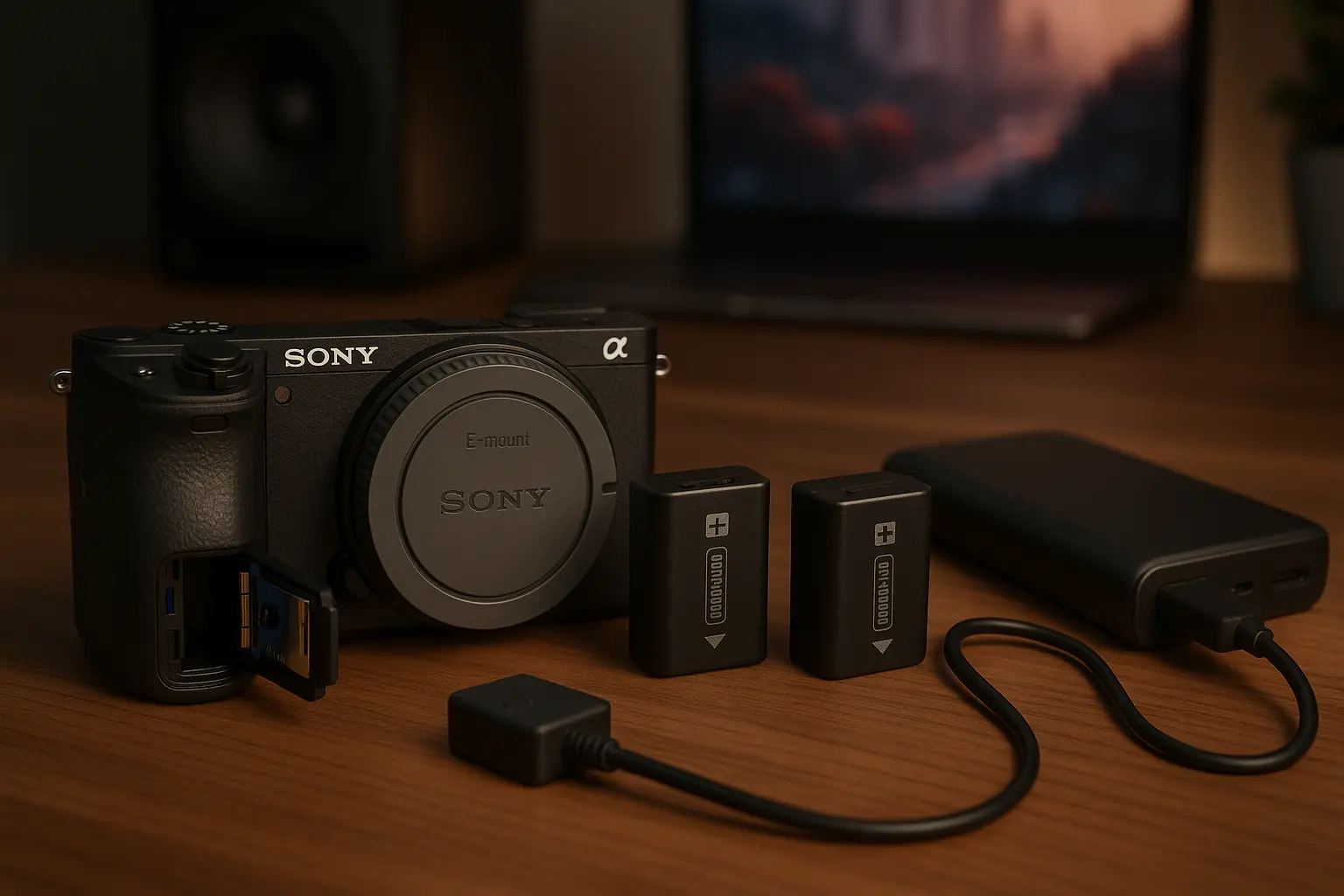
Let’s not mince words: the A6500’s battery life is kinda rough. It uses the older Sony NP-FW50 battery, which is small and gets drained fast by power-hungry features like 4K video and that awesome 5-axis IBIS.
On a typical day of snapping photos with a bit of video, you’re lucky to make it to lunch on one battery. Heavy 4K shooting? You’re looking at maybe 60-75 minutes per charge, tops.
Buy extra Wasabi Power NP-FW50 batteries, Small Rig dual charger: Buy Now
This isn’t a dealbreaker, but you cannot roll with just the battery that comes in the box. You’ll need a plan. Here’s your must-have gear:
| Accessory/Tip | Why You Absolutely Need It |
|---|---|
| Buy Extra Batteries | Non-negotiable. Grab at least three extras. Brands like SmallRig or Wasabi Power have solid value packs with dual chargers. |
| Get a Dummy Battery | Perfect for static shoots like interviews or YouTube videos. Also helps with overheating. |
| Carry a Power Bank | The A6500 charges via micro-USB. You can’t shoot and charge at the same time (it’s slow), but you can top up during breaks. |
Look, the overheating and battery life issues are real, but they’re totally manageable. It’s just the trade-off for getting so much power in such a compact little beast. Plan ahead, and you’ll be fine.
7. Sony A6500 vs A6400 and A6600 in 2025
Alright, if you’re hunting for a used Sony camera, the A6500 isn’t the only one you’ll come across. Its siblings, the A6400 and A6600, are probably staring you down too. They might look like cousins at a glance, but each one’s got its own vibe and trade-offs. Picking the right one? It’s all about figuring out what matters most to you and your wallet.
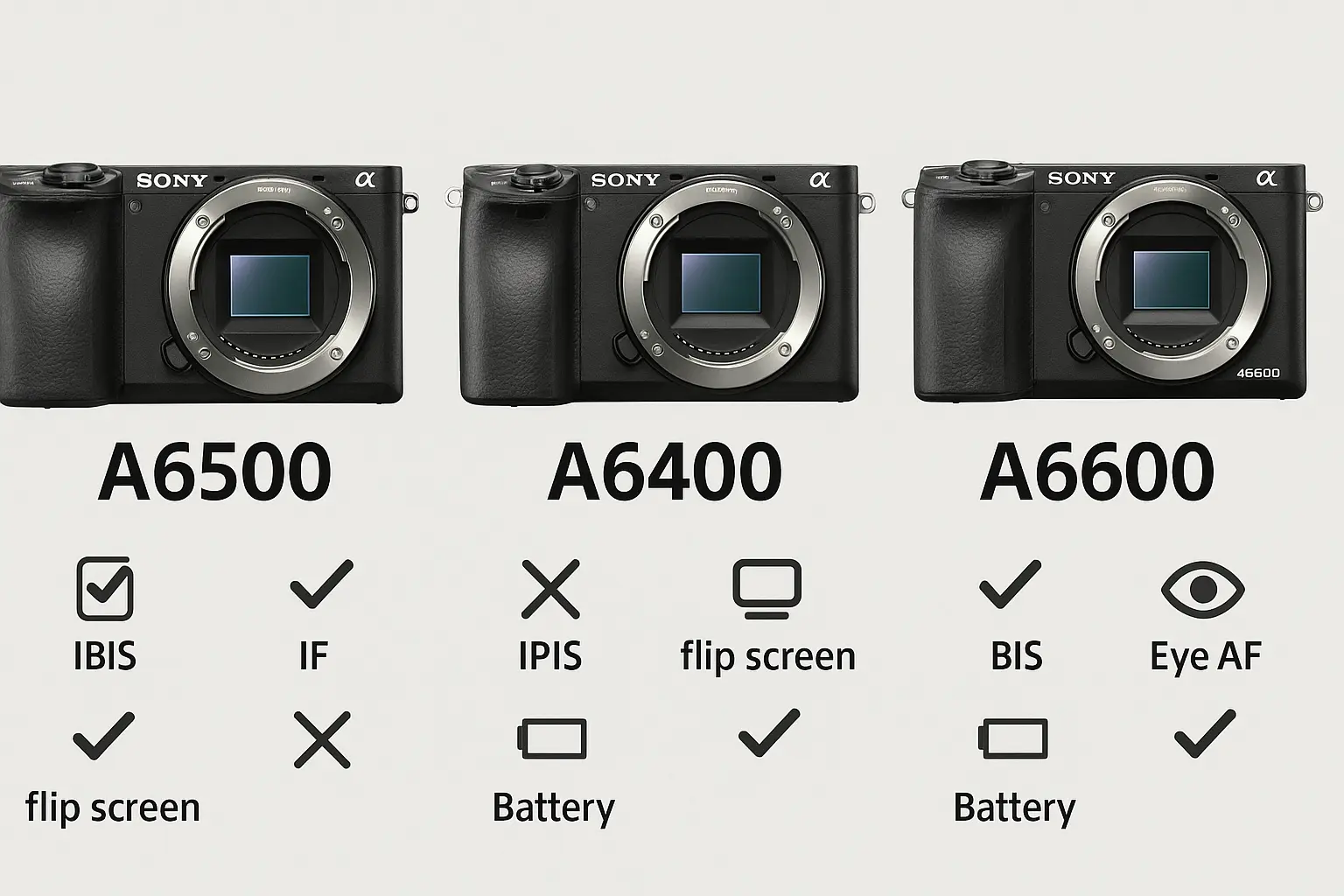
Here’s a clean breakdown of how they compare on the features that matter most:
| Feature | Sony A6500 (2016) | Sony A6400 (2019) | Sony A6600 (2019) |
|---|---|---|---|
| Image Stabilization (IBIS) | ✅ Yes, 5-Axis | ❌ No | ✅ Yes, 5-Axis |
| Autofocus | Excellent Eye AF | ⭐ Upgraded Real-time Eye AF & Tracking | ⭐ Upgraded Real-time Eye AF & Tracking |
| LCD Screen | Tilting only | ✅ 180° Flip-up for vlogging | ✅ 180° Flip-up for vlogging |
| Battery | Old NP-FW50 (Poor) | Old NP-FW50 (Poor) | ⭐ New NP-FZ100 (Excellent) |
| Headphone Jack | ❌ No | ❌ No | ✅ Yes |
| Approx. Used Price (2025) | Lowest | Medium | Highest |
So, Which One Should You Choose?
Looking at the table, the choice gets a lot clearer. It really comes down to what you need and what you’re willing to spend. Here’s the deal:
Choose the A6500 if…
- You’re a photographer or filmmaker who’s all about smooth handheld footage. That 5-axis IBIS is the star of the show.
- You don’t need a flip-up screen for vlogging and are cool with carrying extra batteries.
- You want pro-level stabilization for the cheapest price of the bunch. It’s a steal for the value.
Choose the A6400 if…
- You’re a vlogger or solo creator who needs to see yourself on that 180° flip-up screen.
- You want killer autofocus Real-time Tracking is next-level for keeping subjects sharp.
- You use stabilized lenses (OSS) or shoot with a tripod/gimbal, so you don’t miss IBIS.
Choose the A6600 if…
- You’ve got the cash and want it all: IBIS from the A6500, flip-up screen and autofocus from the A6400, plus a beefy Z-series battery that lasts forever.
- You need a headphone jack to monitor audio for pro shoots.
- You’re after the most complete, no-hassle camera, even if it costs more.
For a lot of budget-savvy creators in 2025, the A6500 is the sweet spot. It’s a tough, stabilized beast that’s hard to beat for the price.
8. Best Lenses for Sony A6500 Mirrorless Camera
Man, one of the best parts about getting a Sony A6500 is the absolute goldmine of lenses you can choose from. The E-mount system is like walking into a camera shop with endless options Sony’s got a ton of great glass, and brands like Sigma and Tamron are dropping budget-friendly gems that don’t skimp on quality. It’s like a playground for photographers!
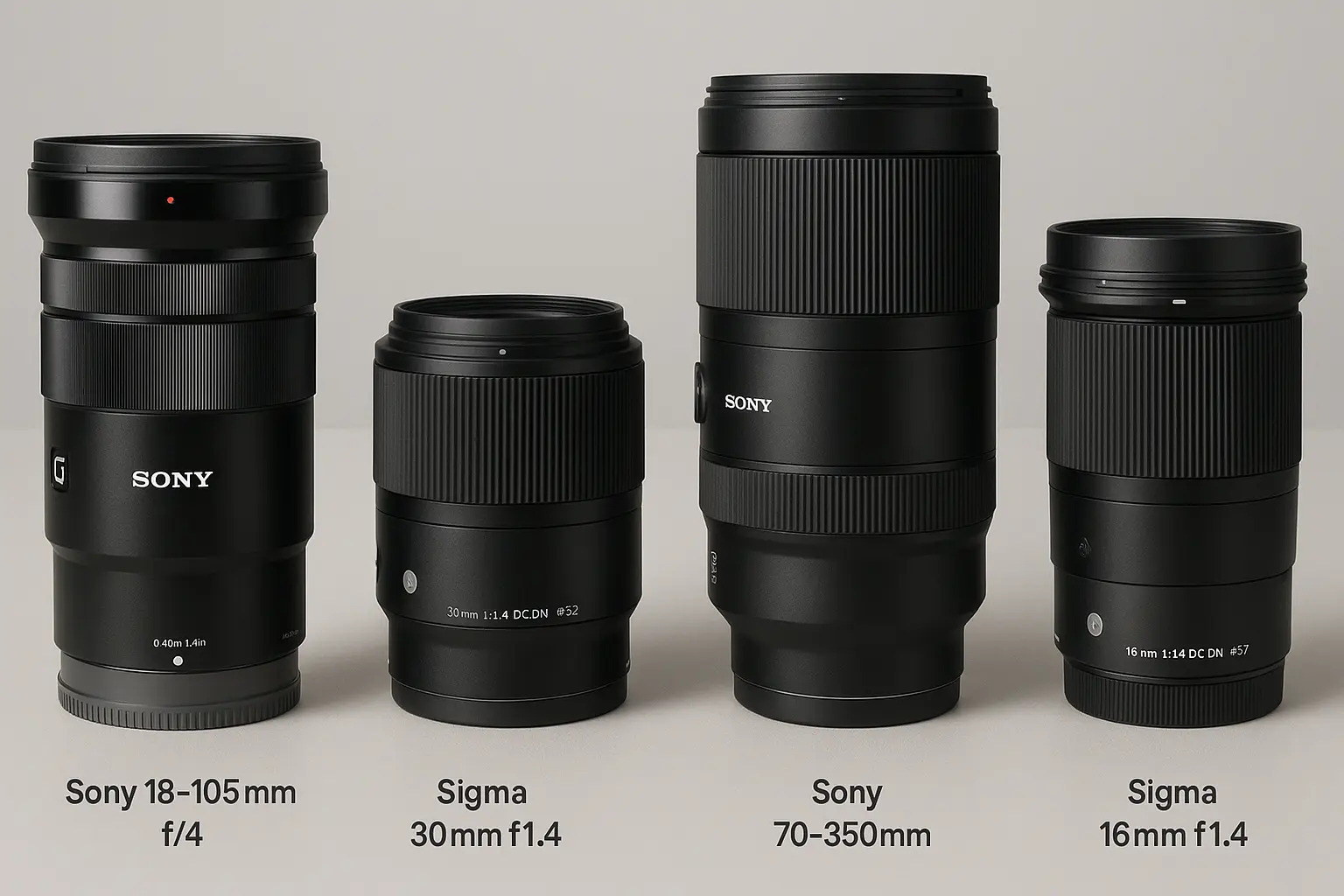
Picking the perfect lens? Yeah, it’s all about what you’re into shooting whether you’re chasing epic sunsets, snapping candid portraits, or zooming in on wildlife. I’ve got a few faves that pair so well with the A6500, and I’m stoked to share why they’re awesome for different vibes.
Best lens for Sony A6500: Buy Now
- The Best All-in-One Travel Lens: Sony E 18-105mm f/4 G OSS
Why I’m obsessed: This lens is your ultimate travel sidekick. It goes from a wide 18mm for those jaw-dropping landscapes to 105mm for tight portraits, so you’re ready for anything a trip throws at you. The f/4 aperture stays steady for video, and the Optical SteadyShot (OSS) works like a charm with the A6500’s IBIS to keep your shots super smooth. It’s the one lens I’d leave on my camera for an entire adventure. - The Best Portrait & Low-Light Lens: Sigma 30mm f/1.4 DC DN | Contemporary
Why I love it: This lens is straight-up magic. That f/1.4 aperture is like a light vacuum, sucking in tons of light for dark indoor shots or nighttime vibes. Plus, it gives you that dreamy, blurry background (hello, bokeh!) that makes your portraits pop like nobody’s business. It’s tack-sharp, perfect for everyday snaps or pro-level portraits, and just feels like a must-have in your bag. - The Best Telephoto Zoom for Wildlife & Sports: Sony E 70-350mm f/4.5-6.3 G OSS
Why I love it: Need to get up close to faraway action? This lens is your ticket. It’s surprisingly light for such a long reach, so it’s awesome for stuff like zoo trips, airshows, or snapping wildlife without scaring it off. The image quality is fantastic, and the OSS is a lifesaver for keeping things steady at those long focal lengths. - The Best Budget Wide-Angle Lens: Sigma 16mm f/1.4 DC DN | Contemporary
Why I love it: This is like the 30mm’s cool sibling, and it’s just as awesome. The super-wide 16mm view is perfect for epic landscapes, city architecture, starry night skies, or even vlogging (if you can deal with the A6500’s non-flippy screen). It’s crazy sharp, the f/1.4 aperture kills it in low light, and the price? Total steal for what you get.
9. Pros and Cons
We’ve dug into all the nitty-gritty details, so let’s break it down to the essentials. If you’re on the fence about grabbing the Sony A6500 in 2025, here’s the quick rundown of what makes it awesome and what might make you pause.
Pros 👍
- That 5-axis in-body stabilization (IBIS) is a total game-changer. It makes handheld videos and low-light shots buttery smooth.
- Super compact and tough as nails with that magnesium alloy body feels like a premium travel buddy you can toss in your bag.
- Photos and 4K video look gorgeous. The image quality still holds its own against newer cameras, no question.
- Autofocus is fast, reliable, and tracks like a champ, so you’re nailing sharp shots without breaking a sweat.
Cons 👎
- No 180-degree flip screen. If you’re a vlogger who needs to see yourself, this one’s a big miss.
- It can get toasty during long 4K video sessions, so you’ll need some tricks to keep it cool for serious shoots.
- Battery life? Meh. It’s not great, and you’ll definitely need to stock up on spare batteries.
- The menu system is old-school and can feel like a maze, especially if you’re new to Sony cameras.
10. Frequently Asked Questions (FAQ)
You’ve got questions about the Sony A6500, and I’ve got answers. These are the ones I hear all the time, so let’s dive in with some straight-up, no-BS thoughts to help you decide if this camera’s your jam.
- Is the Sony A6500 a good camera?
Dude, it’s a total steal for what you pay in 2025! This thing’s fast, powerful, and has that pro-level 5-axis stabilization that makes newer, pricier cameras jealous. It’s a beast for photos and most video projects. Only downside? If you’re a vlogger who needs to check your framing on a flip-out screen, you’ll be left hanging. - Does the Sony A6500 shoot in 4K?
Oh yeah, and it’s stunning. The 4K is why this camera still gets so much love. It pulls off this cool trick where it grabs a 6K image and crunches it down to 4K, so your videos are crazy sharp and detailed. You can go 24fps for that cinematic, Hollywood vibe or 30fps for regular stuff. It’s got you covered either way. - How old is the Sony A6500?
This camera’s got some years on it came out way back in late 2016. That’s over eight years old by 2025! Sounds like a grandpa in tech years, but its features are so legit, it still feels like it’s ready to rumble with the new kids. - Is the Sony A6500 discontinued?
Yeah, Sony stopped making these a while ago, so you won’t find a brand-new one in stores. Your best bet is the used market. Check out places like MPB or KEH they usually have A6500s in solid condition, sometimes with a short warranty to keep you stress-free. - What is the main advantage of the A6500 over the A6400?
One word: stabilization. The A6500’s got this awesome 5-axis in-body image stabilization (IBIS) that the A6400 totally misses out on. That means your handheld videos are super smooth and your low-light shots are sharper, no matter what lens you’re using. It’s like having a trusty wingman that makes every shoot feel effortless.
11. Final Verdict: Should You Still Buy the Sony A6500 Mirrorless Camera in 2025?
So, after geeking out over all the specs, performance, and quirks, we’re back to the million-dollar question: in 2025, with a bazillion newer cameras out there, is the Sony A6500 still worth your hard-earned cash?
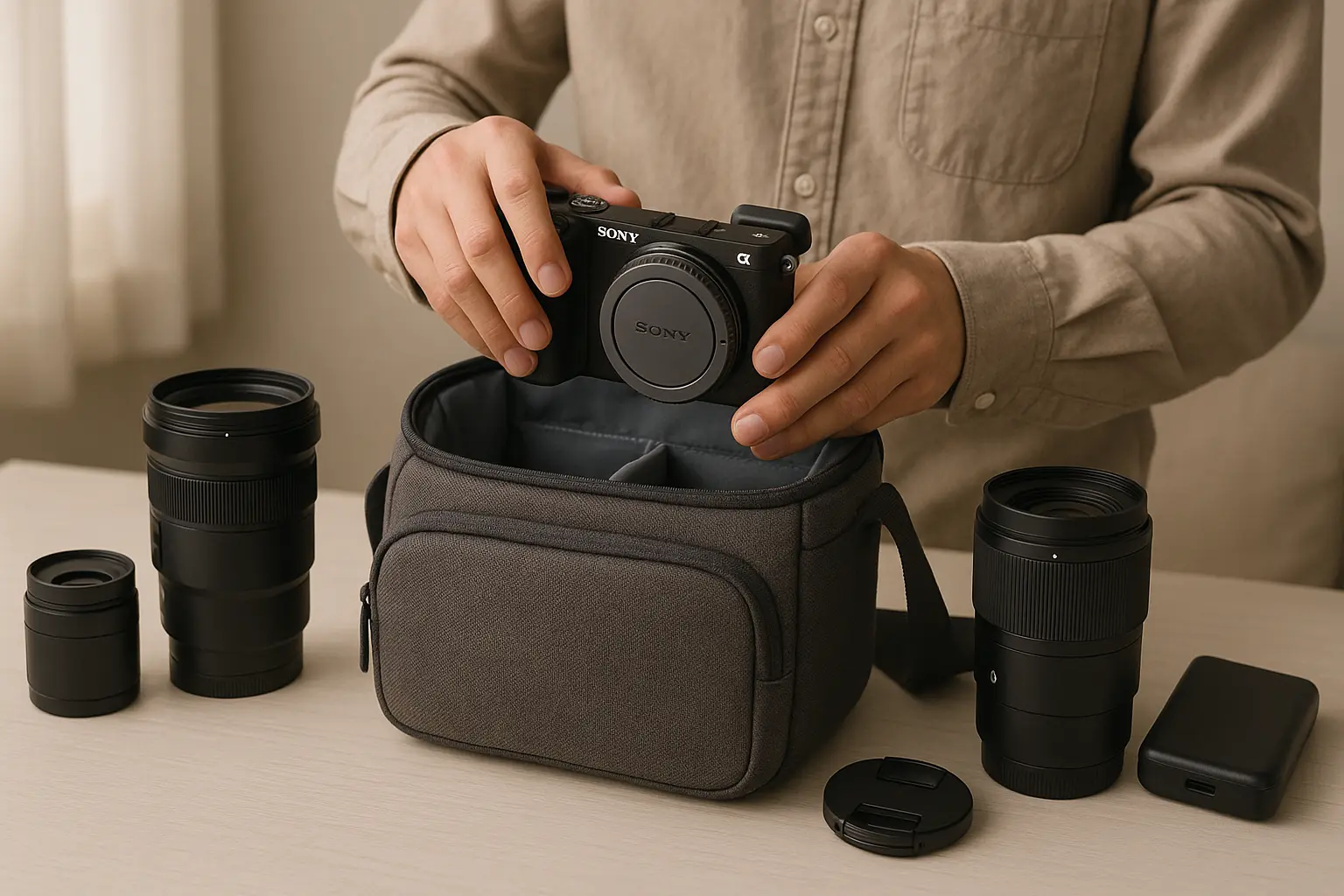
It’s not a straight-up yes or no it really depends on who you are and what kind of content you’re making.
For Photographers:
Heck yeah, I’m all in on this one! The A6500 is a steal for photographers. It’s got a tough-as-nails body, a killer autofocus that locks on like a champ, and image quality that still holds up like nobody’s business. Plus, that 5-axis in-body stabilization (IBIS) is a total game-changer for low-light shots or keeping things steady. You’re getting features that outshine some newer cameras, and on the used market, it’s dirt cheap. It’s a no-brainer for shutterbugs.
For Videographers and Filmmakers:
I’d say yes, but with a little asterisk. The 4K video is drop-dead gorgeous, and that IBIS makes handheld footage look so smooth it’s almost unfair. This thing’s a pint-sized cinema beast. But, you’ve gotta do a bit of prep. You’ll need extra batteries (like, a lot), and you’ve gotta be ready to manage overheating if you’re filming long takes. For short clips, B-roll, or travel videos, it’s an absolute monster. For long events like weddings or interviews? Just plan ahead with some cooling tricks.
Who It’s NOT For:
Vloggers, listen up this one’s a hard pass. If you’re filming yourself for YouTube or TikTok, the lack of a flip-up screen to see yourself is a total buzzkill. You’re better off hunting for a used A6400 or saving up for an A6600.
The Sony A6500 is like that cool, slightly older friend who’s still got all the moves. It’s a secret weapon for creators who care about nailing great images and steady video without needing the latest bells and whistles like a beefy battery or a selfie screen. Yeah, it’s got some quirks, but they’re totally manageable. For the right person, the A6500 isn’t just “still worth it” in 2025 it’s one of the smartest, bang-for-your-buck camera buys you can make.

